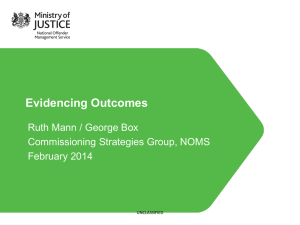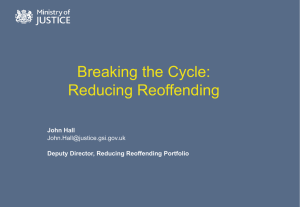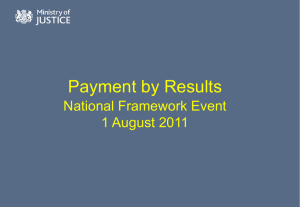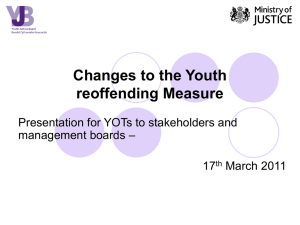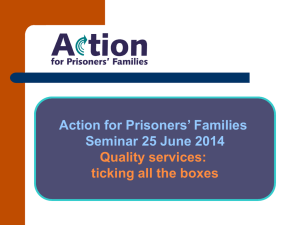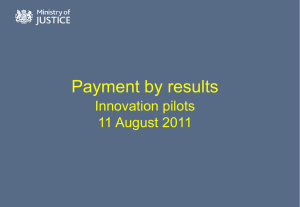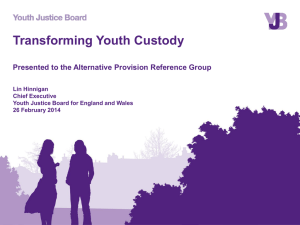Changes to reoffending statistics following the introduction
advertisement
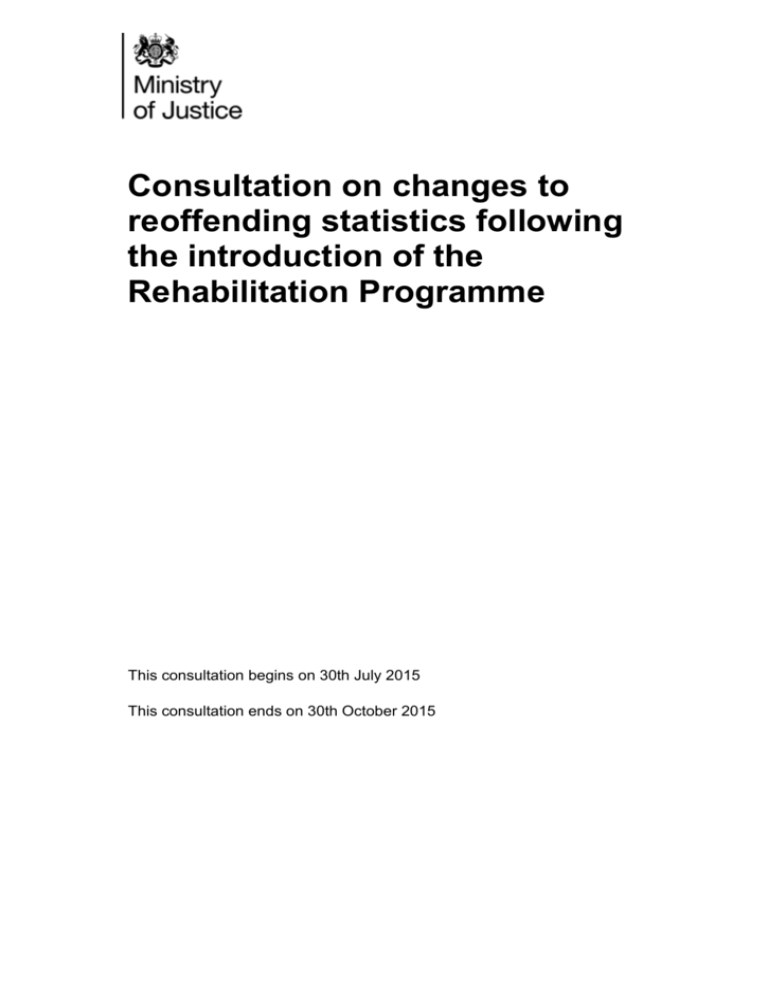
Consultation on changes to reoffending statistics following the introduction of the Rehabilitation Programme This consultation begins on 30th July 2015 This consultation ends on 30th October 2015 About this consultation To: All persons with an interest in reoffending. Duration: From 30th July 2015 to 30th October 2015 Enquiries (including requests for the paper in an alternative format) to: Nick Mavron Ministry of Justice 7th Floor 102 Petty France London SW1H 9AJ Tel: 020 3334 3555 Fax: 020 3334 3669 Email: statistics.enquiries@justice.gsi.gov.uk How to respond: Please send your response by 30th October 2015 to: Nick Mavron Ministry of Justice 102 Petty France London SW1H 9AJ Or email it to: statistics.enquiries@justice.gsi.gov.uk Response paper: A response to this consultation exercise is due to be published by January 2016 on the Ministry of Justice website at www.justice.gov.uk Consultation on reoffending statistics Contents Introduction 3 Chapter 1: Summary of the proposals 5 Chapter 2: The proposals 7 Chapter 3: New quarterly reoffending bulletin structure 13 Detailed proposals on tables in new publication 15 Questionnaire 17 1 Consultation on reoffending statistics This consultation paper sets out the changes to the Ministry of Justice’s reoffending statistics for England and Wales. The consultation falls within the scope of the Code of Practice on Consultation and follows the seven consultation criteria set out at the end of this consultation. The paper will be sent to MoJ's corporate database which includes over 4,000 individual contacts. Recipients will include organisations such as The Howard League for Penal Reform and Civitas. 2 Consultation on reoffending statistics Introduction In “Transforming Rehabilitation: A Strategy for Reform”, published in 2013 the Secretary of State for Justice set out plans to introduce a new system for the management and rehabilitation of offenders in the community across England and Wales. The programme, which was fully implemented in February 2015 aims to bring down reoffending rates while continuing to protect the public. The reforms included: opening up the market to a diverse range of rehabilitation providers from the private, voluntary and social sectors (including mutuals) through 21 Community Rehabilitation Companies (CRCs); using a ‘payment by results’ approach to develop and implement effective ways of rehabilitating offenders and rewarding providers that devise and deliver the most effective rehabilitation programmes; extending statutory rehabilitation to around 45,000 short sentenced offenders released from prison every year, who have the highest reoffending rates and yet previously received no supervision after release; reorganising our prisons to resettle offenders ‘through the gate’, with continuous support from custody to community. This means the majority of prisoners will be moved to a resettlement prison close to their community at least 3 months before release; and creating a new public sector National Probation Service (NPS), to manage high risk offenders. Until the implementation of these reforms most of the probation services were delivered by 35 Probation Trusts under contract to the National Offender Management Service (NOMS) on behalf of the Secretary of State. Through these reforms 21 CRCs are now providing services in their Contract Package Areas (CPAs). The CRCs are owned and run by successful bidders from the recent competition and now deliver services under contract to NOMS. The NPS is a delivery arm of NOMS and delivers services under a service level agreement (SLA) within seven NPS divisions. CRCs manage the majority of offenders in the community sentenced to Community Orders (COs), Suspended Sentence Orders (SSOs) and those subject to licence conditions or supervision requirements, and deliver 3 Consultation on reoffending statistics rehabilitative support to offenders. The NPS directly manage offenders who pose a high risk of serious harm to the public (including those whose risk has escalated to high during the course of their sentence) or those released from custody who have committed the most serious offences. It has a key role at certain stages of the process for all offenders, for example in advising the courts on sentencing, determining the allocation of offenders and dealing with enforcement action, working closely with CRCs. To support the implementation of these reforms the Ministry also introduced IT changes through the nDelius system for recording the flow of offenders released from prison and starting community sentences. The nDelius system also identifies whether an offender is managed by a CRC or the NPS after being sentenced. Besides the impact of switching to the nDelius system the reforms themselves will affect the volume of offenders eligible for probation support. This is a consequence of now having almost all offenders subject to supervision on release from prison, driven in particular by those offenders serving sentences of less than 12 months who would have previously had no statutory supervision. As a consequence of these reforms the Ministry is considering how it places a range of new reoffending statistics into the public domain while making sure they fit coherently alongside existing reoffending breakdowns. 4 Consultation on reoffending statistics Chapter 1: Summary of the proposals The key change we are proposing in this consultation is to to align the existing reoffending measure with those measures necessary for assessing progress against the rehabilitation reforms. This will help support the Ministry in meeting its commitment of statistical best practice by giving a coherent overview of all statistics related to reoffending. As a consequence of these reforms this document sets out and seeks views on three key proposals: 1. To replace the existing reoffending quarterly publication of headline statistical information on adult and juvenile reoffending with one that will include reoffending outcomes for the payment by results (PbR) element of the reforms, split by relevant cohorts and CRCs; and reoffending outcomes for the NPS, split by relevant cohorts and the seven NPS divisions; 2. To replace the ‘adjusted to baseline’ reoffending rates previously available in the proven reoffending bulletin with OGRS4 (Offender Group Reconviction Scale). This will be produced for both adult and juvenile offenders; and 3. To produce interim PbR figures for the first two quarterly cohorts of eligible offenders, and equivalent figures for NPS offenders, until final outcomes for these cohorts become available. This will help to address the information gap created by switching to three month cohorts for reporting reoffending and will allow CRCs’ progress to be assessed at the earliest opportunity. The full proposals are set out in Chapter 2. This package of proposals represents a significant improvement in terms of: a wider range of data available to cover both PbR and the existing reoffending research based questions; the presentation of a coherent overview of reoffending statistics to help understanding; simplifying access to information in line with the Code of Practice; 5 Consultation on reoffending statistics relevance to what the organisation is aiming to achieve; being well-defined, with a clear, unambiguous definition so that data will be collected consistently, and the measure is easy to understand and use; being timely, producing data frequently enough to track progress, and quickly enough for the data to still be useful; being reliable, and accurate enough for its intended use, and responsive to change; and being comparable with published PbR baselines back to 2011 and overall headline reoffending rates going back to 2000. Views are invited from all users of reoffending statistics. In order to ensure we can develop these proposals and publish statistics in a timely fashion, we are asking for responses by 30th October 2015. 6 Consultation on reoffending statistics Chapter 2: The proposals Proposal 1: Quarterly reoffending bulletin We are proposing to replace the existing quarterly reoffending bulletin with one presenting one year reoffending statistics relating to young offenders (age under 18 years) and most adult offenders now managed by CRCs and the NPS. We intend to continue publishing the existing National Statistics publication, until this replacement bulletin is in place from October 2017. We propose that this bulletin will routinely publish one year reoffending statistics, such as binary reoffending rates (the proportion of offenders who reoffend) for CRCs and the NPS which are not currently available. The publication will also include on an annual basis, further geographical level breakdowns for reoffending alongside additional analysis on Serious Further Offences (SFOs) and any new analysis in reoffending statistics that would otherwise have been presented in the compendium of reoffending. This will provide users with the opportunity to comment on emerging work and plans for future work. To align with the PbR measure of reoffending we are proposing the use of: Three month cohorts for all measures of reoffending including for juveniles, which will then align with the adult PbR element of the reforms. Reporting will then be done for each new quarterly cohort rather than for a rolling annual cohort of offenders as used by the current measure of reoffending; and an annual cohort (available on an financial year basis) that combines the preceding quarterly cohorts to calculate both annual binary and frequency measures of reoffending for the PbR element of the reforms. Using this annual cohort to create geographical breakdowns at local authority (LA) level, including those used by the Youth Justice Board (YJB) for breakdowns by Youth Offending Teams (YOTs) Quarterly reporting This bulletin will include one year reoffending rates for a series of quarterly offender cohorts. These cohorts will represent the groups of offenders whose reoffending can also be used to determine the success or otherwise of CRCs at reducing reoffending rates against a fixed baseline, adjusted for changes in the case mix of the offenders being supervised. 7 Consultation on reoffending statistics Cohort creation Each quarterly cohort will comprise of offender starts with each start associated with an offender and an index offence. As is the case for the current reoffending measure, the index offence is the most serious offence associated with the sentence which led to the offender being eligible to join the cohort. Each individual offender will be allocated to a quarterly cohort only once, based on their first entry in a given quarter. Cohorts will be built up on a quarterly basis and will include: all offenders released from a custodial sentence; all offenders who begin a community order (CO); all offenders who begin a suspended sentence order (SSO); all offenders receiving a fine, discharge or other disposals besides immediate custody for court convictions; and all offenders receiving a caution. The PbR cohorts will exclude: offenders who do not receive one of the above disposals; offenders with the following two sentence requirements, or a combination of the two: 1. Standalone Unpaid Work/Community Payback 2. Standalone Electronic Monitoring/Curfew; and foreign national offenders subject to deportation. all offenders receiving a caution Annual cohorts will be formed simply by combining the four quarterly cohorts of the relevant financial year; therefore an individual offender may have up to four starts within a single annual cohort. This differs to the current annual cohort used to produce reoffending rates where an offender is only counted once. The impact of this change is to weight the measure towards the more prolific offenders meaning slightly higher reoffending rates when compared to the current measure 8 Consultation on reoffending statistics of reoffending. The difference is illustrated in Annex 1 outlining the structure of the quarterly report. These changes reflect the need to provide a complete picture of reoffending while monitoring rehabilitation reforms which is easily accessible to all. Impacts of the change: The proposed measure aligns with the PbR measure so that we maintain a single framework for measuring reoffending - feedback from the previous consultation in 2011 suggested a single measure of reoffending was preferred to the many different measures that previously existed. However, three month cohorts limit the scope for geographical breakdowns owing to the smaller number of offenders. Counting rules for the annual cohorts will differ slightly to the quarterly cohorts. This is because the annual cohorts are created though combining the four quarterly cohorts so an offender is not necessarily unique, appearing up to four times. Question 1 – Do users agree with changing to three month cohorts to measure all reoffending (not just PbR outcomes) and the creation of annual cohorts, combining the preceding quarterly cohorts, to permit geographical breakdowns at LA level, including those used by the Youth Justice Board (YJB) for Youth Offending Teams (YOTs) Proposal 2: Replacing ‘adjusted to baseline’ binary reoffending rates by OGRS4 As proven reoffending is related to the characteristics of offenders, the actual rate of proven reoffending will depend, in part, on the characteristics of offenders coming into the system. This actual rate provides users with sufficient information on what the level of reoffending is (e.g. in their local area) and how it is changing over time. In addition to the actual rate, earlier reoffending publications also included an ‘adjusted proven reoffending rate’ to control for differences in the composition of the offender group. This was created to allow users to understand how changes in types of offenders coming through the justice system drive reoffending rates. In place of this ‘adjusted rate’ which is no longer published we are proposing to use the OGRS4 (Offender Group Reconviction Scale) score to control for differences in offender characteristics across different offender groups for both 9 Consultation on reoffending statistics adults and juveniles. OGRS4 is based on a well-established, peer-reviewed methodology for assessing and representing reoffending risk. Headline reoffending rates (excluding frequency measures) will be adjusted by using OGRS4, to take account of the influence that differences in offender mix can have on binary reoffending rates before being used to determine PbR outcomes. OGRS4 uses age, gender and criminal history to assess the reoffending risk of a given group of offenders by producing a score between 0 and 1. These scores can be used to compare the relative likelihood of reoffending either over time or between different groups of offenders, with a higher rate meaning a group of offenders who are more likely to reoffend. The OGRS-adjusted reoffending rate for a given CRC cohort will be calculated as the observed reoffending rate for that quarterly/annual cohort plus any difference between the OGRS4 score in that cohort and the 2011 CRC baseline cohort. This calculation effectively standardises the mix of offenders in each cohort of a given CRC to the 2011 mix for that same CRC. A similar approach will be used for the NPS regions. Impacts of the change: OGRS is a well established approach for assessing an offender’s risk of reoffending and is the agreed methodology for adjusting PbR reoffending rates. It can be easily replicated and offender managers are already familiar with its use across the justice system. Many of the key variables used by the ‘adjusted rate’ to model reoffending risk are used by OGRS4. It is however a model specifically developed for adult offenders so some care will need to be taken in its use for all young offenders. Rather than providing an actual ‘predicted’ rate of reoffending, OGRS4 uses a scale from between 0 and 1 to assess an offender’s risk of reoffending. Question 2 – Are users content with the use of OGRS4 for all offender groups for assessing the likelihood of reoffending? Proposal 3: Quarterly interim PbR measures and equivalent NPS measures of reoffending Since the first headline PbR figures for Cohort 1 (October to December 2015) will not be available until October 2017 we are proposing to produce interim PbR figures for the first two cohorts until final outcomes for these cohorts become available. This will help to address the information gap created by switching to three month cohorts for reporting reoffending and allows CRC’s progress to be assessed at the earliest opportunity. We also propose to produce the equivalent 10 Consultation on reoffending statistics interim figures for the first two NPS cohorts over the same period, broken down by NPS division. There are two possible interim measures to consider: 1. Reoffending rates with defined follow up and waiting periods We currently produce ‘interim estimates’ for the PbR prison pilots, which use shorter follow-up and waiting periods that we update quarterly as more data becomes available. These are intended to provide users with an early indication of progress against targets until final outcomes become available and are published in the proven reoffending bulletin in Annex A. The main advantage in adopting this measure for CRCs and NPS divisions is that the follow up and waiting period is the same for each offender in a cohort with users already familiar with its presentation in the published interim results for the prison pilots. 2. Reoffending to date Instead of measuring reoffending with a defined follow up and waiting period, this interim estimate would count any proven reoffending to date as recorded on MoJ’s PNC data extract. Unlike the first option this will mean some offenders in the three month cohort will have a longer follow up period in which to reoffend. Despite this difference its key advantage is to provide users with a more accurate picture of reoffending to date and, furthermore, we will compare any interim figure with the corresponding figure from the baseline period (for PbR outcomes, the baseline period is calendar year 2011, and we would use the same baseline for any NPS interim measure too). For this very reason we are proposing to use the ‘reoffending to date’ measure to produce interim reoffending information. While this does not represent real time MI, which CRCs might be able to procure themselves through local police force arrangements, it will provide our best indication of progress to date for both CRCs and NPS divisions. We propose publishing this as management information, making it available to all interested for the first two PbR cohorts which will make up the first annual PbR cohort for the financial year ending March 2016 Impacts of the change: This proposal addresses the desire of users, including the CRCs and the NPS divisions, to have early indicators of progress in an accessible format. CRC’s are not obliged to share the real time reoffending information they collect so this management information will address this information gap until headline results are published. These estimates, however, will only give an indication of progress and therefore care should be taken when interpreting them. Aside from the risk of over interpreting these figures, there is also the risk of creating confusion by presenting management information and headline measures for different cohorts of offenders at the same time. 11 Consultation on reoffending statistics Question 3 - Does the proposal for providing ‘interim estimates’ for publication as management information until headline results become available, cover users’ needs? 12 Consultation on reoffending statistics Chapter 3: New quarterly reoffending bulletin structure 1. The existing adult and juvenile reoffending statistics will continue in their current form until TR results become available. 2. The new publication would comprise three main sections: a. An overview of reoffending statistics available; a brief summary of the National Statistics and the differences in methodology/coverage from those presented in the previous publication; b. headline reoffending figures following the availability of results from the CRC and NPS cohorts, although any comments on the current measures are welcomed and will feed into options as part of the response to this consultation; and c. Less regular statistics that would be updated in the annual bulletin including long term reoffending rates. 3. The regular statistics we plan to include on a quarterly basis for each specific breakdown are: Binary reoffending rate (reoffenders/ starts) Frequency reoffending rate (reoffences/ reoffenders) Average OGRS4 score (average of the OGRS4 score) plus three supporting values: Number of starts Number of reoffenders Number of reoffences 4. Providing a CSVs and pivot tables so that a complete breakdown of reoffending by each sentence type and combination for Community Orders and Suspended Sentence Orders (and when available, the new Rehabilitation Requirement Order). This will give more detail than currently published as National Statistics 5. In addition the annual statistics will also include breakdowns of reoffending by a. YOTs b. CSPs 13 Consultation on reoffending statistics c. Upper tier LA d. Resettlement prison Question 4 – Do users support the outline structure for the bulletin including reoffending splits by CRCs and the NPS divisions? Historical data We propose that reoffending rates for the annual cohorts will be provided at the national level back to 2000 to ensure trends are available on the same time series as the current measure, and since this is the earliest date from which the data source can be reliably produced. We would provide local-level breakdowns of this data back to 2005 to provide a trend for local areas. Data will not be provided at local level further back than 2005, reflecting both concerns over quality of postcode information and the resources required to produce this additional data. Overall impact of all the proposed changes compared to the published National Statistics on reoffending A comparison of the numbers of offenders included and the reoffending rate for adults on the current national measure and on the proposed new measure for 2012 are presented below.It has been included to provide an indication of the impact of changing the cohort and the figures presented may not exactly match those in any future publication. Also, if changes are made as a result of this consultation or other feedback, this may affect the results produced. Proportion of adult offenders who reoffend in the current national measure and proposed measure: 2012 data Reoffending rate Number of offenders Current measure (12 month cohort) Proposed measure (Jan-Mar 2012 cohort) 35.2 40.5 183,000 56,000 Using a quarterly cohort will mean that we over represent prolific offenders. This increases the proportion of adult offenders who reoffend by around 5 percentage points. 14 Consultation on reoffending statistics Detailed proposals on tables in new publication Table 1 below outlines the proposed coverage of the new bulletin, and Table 2 shows the proposed changes to existing tables. We intend to also publish this information in CSV files and pivot tables, providing users with a more flexible format for locating and extracting the specific information they require. We intend to make these changes with the existing reoffending publication from October 2015 onwards so that users will become familiar with this new format. An example of this format is provided in the reoffending bulletin published alongside this consultation. Table 1 – Table outline for new bulletin Proposed Description table Overview section Headline statistics on overall, adult and 1 juvenile reoffending Back data available 2 (a,b) Yes from 2000 3 (a,b) 4 5 6 7 8 9 10 11 12 Reoffending rates by disposal (includes OCDs), adults (a), juvenile (b) Reoffending rates by custody length, adults (a), juvenile (b) CRC/NPS Reoffending rate for CRCs and NPS divisions, including by PbR-eligible cohorts (i.e. the ongoing PbR outcomes for each CRC) Custody reoffending rate for CRCs and NPS divisions Custody less than 12 month reoffending rate for CRCs and NPS divisions Reoffending rate for court order starts for CRCs and NPS divisions For inclusion in the annual publication (combined cohort) Reoffending rate for resettlement prisons Reoffending rate for upper tier LA Reoffending rate for police force area/CSPs Reoffending rate for YOTs Additional tables on SFOs, restricted patients, long term reoffending rates and other topics of interest. Yes from 2000 Yes from 2000 No No No No No Yes from 2005 Yes from 2005 Yes from 2005 N/A 15 Consultation on reoffending statistics Table 2 - Current national statistics tables and proposed changes Current table Table 1 Table 2 Table 3 Table 4a Table 5a,b,c Table 6a,b,c Table 7a,b,c Table 8 Table 9 Table 10 Table 11 Table 12 Table 13a,b,c Table 14a,b,c Table 15 Table 16a,b,c Table 16b,b,c Table 17a Table 17b Table 18 Table 19 Table 20a Table 20b Table 21 Table 22 Table 23 Table 24 Table 25 Availability Quarterly and Pivot/CSV Quarterly and Pivot/CSV Quarterly and Pivot/CSV Annual and Pivot/CSV Quarterly and Pivot/CSV Quarterly and Pivot/CSV Removed Quarterly and Pivot/CSV Annual and Pivot/CSV Annual and Pivot/CSV Annual and Pivot/CSV Annual and Pivot/CSV Annual and Pivot/CSV Annual and Pivot/CSV Annual and Pivot/CSV Quarterly and Pivot/CSV Quarterly and Pivot/CSV Quarterly and Pivot/CSV Quarterly and Pivot/CSV Annual and Pivot/CSV Annual and Pivot/CSV Removed Removed Quarterly and Pivot/CSV Removed Removed Removed Removed Reason for change N/A Greater flexibility Greater flexibility N/A Greater flexibility Greater flexibility No users identified N/A Greater flexibility Greater flexibility Greater flexibility Greater flexibility N/A N/A CSP shrinking cohort/numbers too small N/A N/A N/A N/A Greater flexibility Greater flexibility No longer relevant No longer relevant Greater flexibility No longer relevant No longer relevant No longer relevant No longer relevant Question 5 – Are users content with the proposed removal of existing tables and the use of pivot tables and CSV files (with appropriate disclosure measures) for additional breakdowns of reoffending data? Question 6 – Are users content with including certain statistics which show little quarterly change, for example long term reoffending rates for inclusion in an annual publication? 16 Consultation on reoffending statistics Questionnaire We would welcome responses to the following questions set out in this consultation paper. Question 1 – Do users agree with changing to three month cohorts to measure all reoffending (not just PbR outcomes) and the creation of annual cohorts, combining the preceding quarterly cohorts, to permit geographical breakdowns at LA level including those used by the Youth Justice Board (YJB) for Youth Offending Teams (YOTs) Question 2 – Are users content with the use of OGRS4 for all offender groups for assessing the likelihood of reoffending? Question 3 - Does the proposal for providing ‘interim estimates’ for publication as management information until headline results become available, cover users’ needs? Question 4 – Do users support the outline structure for the bulletin including reoffending splits by CRCs and the NPS divisions? Question 5 – Are users content with the proposed removal of existing tables and the use of pivot tables and CSV files (with appropriate disclosure measures) for additional breakdowns of reoffending data? Question 6 – Are users content with including certain statistics which show little quarterly change, for example long term reoffending rates for inclusion in an annual publication? Thank you for participating in this consultation exercise. 17 Consultation on reoffending statistics About you Please use this section to tell us about yourself Full name Job title or capacity in which you are responding to this consultation exercise (e.g. member of the public etc.) Date Company name/organisation (if applicable): Address Postcode If you would like us to acknowledge receipt of your response, please tick this box (please tick box) Address to which the acknowledgement should be sent, if different from above If you are a representative of a group, please tell us the name of the group and give a summary of the people or organisations that you represent. 18 Consultation on reoffending statistics The consultation criteria The seven consultation criteria are as follows: 1. When to consult – Formal consultations should take place at a stage where there is scope to influence the policy outcome. 2. Duration of consultation exercises – Consultations should normally last for at least 12 weeks with consideration given to longer timescales where feasible and sensible. 3. Clarity of scope and impact – Consultation documents should be clear about the consultation process, what is being proposed, the scope to influence and the expected costs and benefits of the proposals. 4. Accessibility of consultation exercises – Consultation exercises should be designed to be accessible to, and clearly targeted at, those people the exercise is intended to reach. 5. The burden of consultation – Keeping the burden of consultation to a minimum is essential if consultations are to be effective and if consultees’ buy-in to the process is to be obtained. 6. Responsiveness of consultation exercises – Consultation responses should be analysed carefully and clear feedback should be provided to participants following the consultation. 7. Capacity to consult – Officials running consultations should seek guidance in how to run an effective consultation exercise and share what they have learned from the experience. These criteria must be reproduced within all consultation documents. 19 Consultation on reoffending statistics Consultation co-ordinator contact details Responses to the consultation must go to the named contact under the How to Respond section. However, if you have any complaints or comments about the consultation process you should contact the Ministry of Justice consultation co-ordinator at consultation@justice.gsi.gov.uk Alternatively, you may wish to write to the address below: Ministry of Justice Consultation Co-ordinator Legal Policy Team, Legal Directorate 6.37, 6th Floor 102 Petty France London SW1H 9AJ 20
